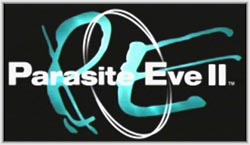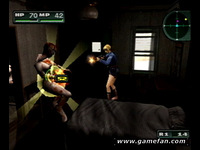|
|

|
PLATFORM
|
PS1
|
BATTLE SYSTEM
|

|
INTERACTION
|

|
ORIGINALITY
|

|
STORY
|

|
MUSIC & SOUND
|

|
VISUALS
|

|
CHALLENGE
|
Hard
|
COMPLETION TIME
|
Less than 20 Hours
|
|
OVERALL

|
+ Looks good for PS1
+ Interesting story patches
- Excruciating controls
- Aggravating inventory
- Constricted visibility
|
Click here for scoring definitions
|
|
|
Once upon a time, a company called Capcom came upon a cash cow series known as Resident Evil. Seeing the success of this series, Squaresoft decided to try for some of the big bucks being accrued with its own take on the formula. Whatever its problems, the first Parasite Eve was a unique entity in the world of RPGs, but Parasite Eve II strips that away to unabashedly rip off Capcom's big 32-bit success story. This makes the continuing adventures of Aya Brea horrifying indeed, but not necessarily in the way envisioned by its makers.
The horror of Parasite Eve II stems most strongly from its controls, which have been freely lifted from Resident Evil's absurdly constraining system. Moving Aya Brea around environments in the first Parasite Eve was self-explanatory, but now only pressing straight up will cause her to begin forward motion. Pressing in other directions will produce the odd sight of Aya being forced to turn around in circles endlessly. Inadvertently switching back and forth between the forced angles within every room is a common event, and it is caused primarily because getting Aya to change direction without inducing dizziness requires an amazingly precise hand. Absent superb dexterity one can expect to be constantly enraged when Aya fails to go in the intended direction.
The controls are simply obnoxious most of the time, but in battles that demand quick reaction time they cross the line to become incandescently infuriating. Survival is aided by the programmers' decision to let Aya walk straight through enemies frequently, without which getting trapped would be all too easy. If the enemy AI were better, Parasite Eve II would be reserved only for gamers with nerves of steel, but taking advantage of patterns keeps the challenge at a surmountable stage — even when Aya tries to run in place instead of removing herself from the path of telegraphed projectiles.
Even without the constant challenge of steering Aya, battles in Parasite Eve II are a significant step up in frustration from the first game. Instead of battles taking place on a single screen, areas come laden with a number of set views to which the camera automatically shifts as Aya moves. This means that enemies are quite often invisible from the original perspective when the fight was begun, and finding them may not be pleasant.
 I sure would, if the game would let me. I'm not that lucky.
I sure would, if the game would let me. I'm not that lucky.
|
|
The best way to locate enemies that refuse to share the screen with Aya is to use the automatic targeting feature of the game to shoot and see what happens. Shooting at enemies the camera does not currently display is vital to progress, but nevertheless laden with issues. Visible targets can appear on enemies that are currently blocked by pieces of the landscape, with no way of determining when they can be shot except spraying bullets everywhere. A second means by which Aya can be prevented from shooting the opposition stems from her needing to face the foe, because the game will allow her to shoot holes in the scenery if she fires at a target not currently in her line of sight. Particularly if she just ran away from something, this can result in Aya shooting in mid-turn to waste time and munitions.
Unlike the first game, wasting munitions is a considerable risk. Aya usually has to expend multiple clips of ammunition to deal with her adversaries, and enemies usually aren't kind enough to bequeath her with adequate resupply when they die. She is also unable to increase her inventory capacity beyond twenty items in total, and Parasite Eve II forces her to equip anything for use in battle onto her armor, further constraining the limited supplies available. Keeping things Aya cannot hold on her person requires running back and forth between several boxes that store spare materials, a cumbersome process.
What makes the difference in many fights will be Aya's magical abilities, which can tip the scale toward victory. Learning spells and upgrading their power is also the only use for experience in the entire game. Using them in battle is still aggravating because enemies can attack during the casting time to cause a short circuit, but their judicious application will make many fights much easier.
Three years after the immolation of thousands in New York when their own mitochondria generated far too much energy, Aya Brea is an FBI agent operating in the specialized MIST department that investigates further outbreaks of aggressive mitochondrial takeover. An outbreak in a crowded office building of Los Angeles peters out early on, and Aya gets the seemingly inconsequential job of checking out a southwest desert pit stop called Dryfield. Appearances are quite deceiving in this case, and Aya finds a gigantic nest of neo mitochondrial creatures menacing the sole surviving inhabitant.
 Aya carries a lucky card deck around to deploy as a weapon.
Aya carries a lucky card deck around to deploy as a weapon.
|
|
It seems Eve's absence prevents people from the spontaneous combustion that occurred on a large scale in New York, which at least explains why Aya isn't the only one combating creatures menacing the southwest. If one can accept the fairly large contrivance that an underground shelter James Bond villains would envy was constructed entirely in secret in the desert southwest, the story is actually interesting in parts. The idea that a group would attempt to engineer the forced transformation/destruction of the human race is not new, but the things Aya learns while exploring are fascinating, and balance some of the stupider elements of a story that finds a solitary FBI agent given no backup when fighting hundreds of mutant monsters that pose a definite threat to national security.
Parasite Eve II does demonstrate that PS1 visuals improved toward the end of the console's lifespan. Characters are fairly well defined, environments look good, and enemies generally look like the things they are supposed to be. The FMV sequences look best in typical Square fashion, but the in-game graphics avoid the eye-searing nature of many earlier PS1 3D releases.
Naoshi Mizuta's score mostly veers toward being atmospheric instead of a compelling listen on its own, and in certain parts the repetition of one or two chords ad nauseum gets annoying. A few investing compositions toward the end of the game do not make up for the paucity of good ones during the bulk of playtime. Sound effects offering clues that the visuals do not supply are meant to substitute for music most of the time, but their audio clarity is not stunning enough to make up the difference.
Parasite Eve II has almost nothing left to be considered an RPG, but that wouldn't matter if the core game were enjoyable. Its constantly aggravating control issues make that a challenge, and in tandem with the irritating inventory and befuddling battle views the package is a constant chore. The game does a few things well enough, but the experience of playing it involves never-ending frustration. No wonder Square left the Parasite Eve IP dormant for eleven years after this.
Review Archives
|









